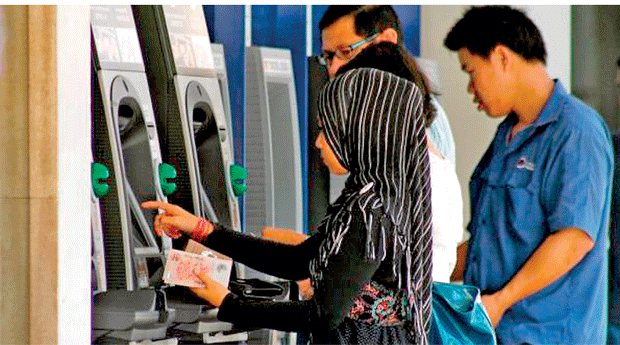24 Nov 2017 - {{hitsCtrl.values.hits}}
Global financial markets are booming. Central banks in advanced economies are in tacit competition mode to extend their ultra-loose monetary policy as long as they possibly can.
On the one hand, the global economy is enjoying a robust and synchronized recovery. On the other hand, however, central banks are maintaining an extremely cautious stance on acting on this and switching gears back to the normal policy level
This is partly due to a legacy effect. Zero or even negative interest rates, coupled with aggressive asset purchases by central banks, have been praised as a key factor in spurring the current economic recovery.
It seems that central banks don’t want to cause harm to such credit by hastily exiting credit and liquidity laxity.
By announcing that it will continue to buy €30 billion (US $ 34.8 billion) in bonds per month at least until September next year and keep interest rates low beyond then, the European Central Bank (ECB) placated market players’ concerns about an imminent end to loose monetary policy in the Euro area.
Equity markets on both sides of the Atlantic have welcomed the move, which has further lowered German bund and the UK guild yields.
With Jerome Powell, nominee to become the new Chair of the US Federal Reserve, expected to support policy continuity, this may signal a yawning interest rate differential between the US and European Union.
What does this have to do with Asia? Although the policy metrics of central banks in advanced economies may not include Asian economies, Asia is not immune from the impact of changing global monetary policy and financial market conditions.
Time for caution

 The Asian Development Bank’s (ADB) recent Asian Economic Integration Report 2017 noted that inward debt investment to Asia fell by US $ 13.9 billion in 2016, a reversal of the US $ 28.8 billion increase in 2015. But inward equity investment climbed by US $ 167.6 billion, much higher than US $ 46.7 billion increase in 2015.
The Asian Development Bank’s (ADB) recent Asian Economic Integration Report 2017 noted that inward debt investment to Asia fell by US $ 13.9 billion in 2016, a reversal of the US $ 28.8 billion increase in 2015. But inward equity investment climbed by US $ 167.6 billion, much higher than US $ 46.7 billion increase in 2015.
Both the EU’s and US’ portfolio equity investments were robust. With debt investment to Asia also recovering in 2017, total financial flows into the region seem to be growing as strong as ever.
This could be a good sign for regional economies, as it may reflect foreign investor confidence in Asia. However, an examination of global financial conditions calls for a more cautious interpretation.
Financial inflows reflect a search by investors for yield, both for bond and equity. But more fundamentally, they are spurred by expanding global liquidity and credit cycle. The global economy is at the latter phase of that cycle and there is a lack of sufficient investment opportunities worldwide.
Look at US stock markets. The Dow Jones and S&P indexes are hitting historical highs almost every week, along with equally historically low market volatilities. There’s no doubt that a significant degree of investor complacency underlies this.
If capital flows into Asia are driven more by the global liquidity cycle than by economic fundamentals, these flows can ebb at any time and at any speed. In this sense, the recent policy stance reaffirmed by the ECB is not encouraging for Asian economies and financial markets.
The global liquidity cycle should be normalized and the credit binge reduced before asset price bubbles are created. Hence, Asia needs to stay vigilant so things do not get out of control.
Unfortunately, Asian financial markets are becoming more and more susceptible to potential market corrections and capital flow reversals triggered by factors such as geopolitical risk or economic policy failures. So, what steps could correct this trend?
Policy actions
The crucial step is for Asian policymakers to start preparing.
First, early detection and preemptive response to any buildup of financial risk is critically important. Policy makers can do this in three ways:
1. Maintain sound macroeconomic policies—including a flexible exchange rate and adequate foreign exchange reserves—to maintain investor confidence.
2. Adopt an effective macroprudential policy framework to prevent excessive credit growth and asset price inflation.
3. Enhance risk management systems by upgrading prudential regulation and supervision.
Second, in the medium to long term, deepening and broadening regional financial markets and financial systems are essential for financial efficiency and resilience. A more developed and regionally integrated banking and financial market can improve efficiency in channelling regional savings into real, productive investment.
Third, further reforms are needed to make economies more resilient and ensure sustainable and inclusive growth. Crisis lessons remind us that sound economic fundamentals are the key to resilience.
The region requires greater revenues from tax reforms and better collection to finance infrastructure and social sector needs. Fiscal policy can also play an important long-term role in enhancing an economy’s productivity and growth potential.
The global economy is entering uncharted territory, with sustained economic growth coupled with low inflation and close to full employment. This emerging scenario puzzles economists as well as policymakers.
In uncertain times, it’s best not to rely on probabilities. Instead, the region’s economies should check their fundamentals once again and take precautionary measures against potential risks.
(Jong Woo Kang is Principal Economist, Economic Research and Regional Cooperation Department, the Asian Development Bank)
25 Nov 2024 54 minute ago
25 Nov 2024 57 minute ago
25 Nov 2024 2 hours ago
25 Nov 2024 3 hours ago
25 Nov 2024 4 hours ago